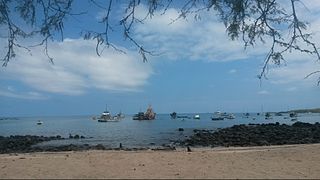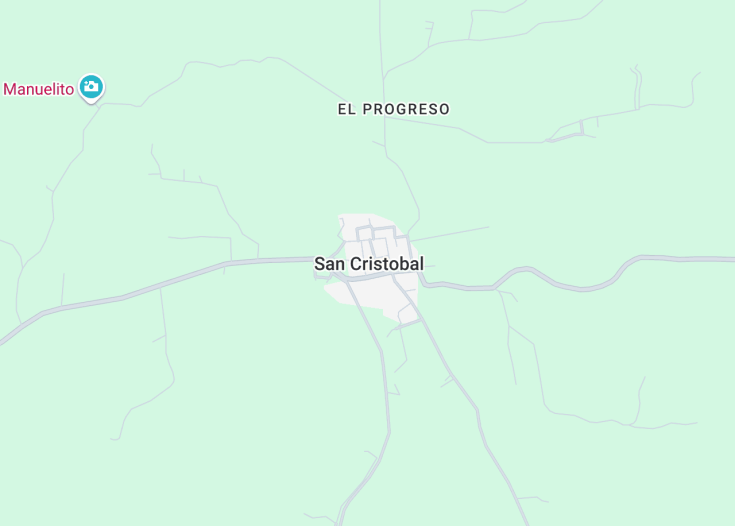San Cristóbal, the easternmost island in the Galápagos archipelago, is a magnificent blend of nature’s marvels and rich history. Esteemed as the first island that Charles Darwin visited during his voyage on the HMS Beagle, it offers a unique educational experience alongside breathtaking landscapes.
From the iconic Kicker Rock, a towering sea cliff, to its vibrant capital, Puerto Baquerizo Moreno, San Cristóbal provides a diverse array of wildlife and pristine beaches, perfect for both relaxation and adventure-seeking travelers.
Make sure to visit La Lobería, a haven for sea lions, where you can observe these playful marine mammals in their natural habitat.
Plan your trip between June and November when the water is calmest, ideal for snorkeling and witnessing the rich marine life of the island.
Top things to do & see in San Cristóbal
Select the following sights and activities to discover best tickets and tours available in San Cristóbal.
San Cristóbal: A Gateway to Nature’s Marvels
| Country | Ecuador |
| Time in San Cristóbal | GMT-6 |
| Language spoken | Spanish |
| Population | 8,000 (2022 estimate, World Population Review) |
| Currency | Ecuadorian sucre (S/. ECS) |
| Airports |
|
San Cristóbal is one of the enchanted islands of the Galápagos archipelago rich in biodiversity and vibrant ecosystems. This island serves as a prime destination for naturalists, researchers, and tourists from around the globe due to its unique fauna and geological features. Overlooking the Pacific Ocean, it houses the administrative capital of the province, Puerto Baquerizo Moreno, and hosts the main airport connecting the archipelago to mainland Ecuador.
Historically, San Cristóbal was one of the first islands to be inhabited in the archipelago, with settlements dating back to the mid-19th century. It played a pivotal role during World War II as an American airbase. Today, it is revered not only for its historical significance but also for its commitment to conservation efforts, which include restoring its natural habitats invaded by non-native species.
The island’s highlands are lush and invigorating, offering a contrasting landscape to the sandy beaches and mangroves that mark its shores. Tourists can delve into activities like snorkeling, sea kayaking, and hiking or enjoy more serene outings such as bird watching and exploring the quiet streets of Puerto Baquerizo Moreno.
San Cristóbal also serves as a crucial study area for scientists investigating evolutionary biology, thanks in part to its diverse flora and fauna, including giant tortoises, sea lions, and numerous species of birds. This not only enhances the island’s scientific value but also helps in promoting sustainable tourism that educates visitors on the significance of ecological preservation.
Where is San Cristóbal?
San Cristóbal is located in the eastern part of the Galápagos Islands in Ecuador, positioned directly west of mainland Ecuador in the Pacific Ocean.
Distances:
[Create a table with the following columns: “Route”, “Distance by car”, “Time by car”. List the most popular routes from major cities in Ecuador to San Cristóbal, and fill in the respective data without approximations.]
| Route | Driving Distance to Airport | Driving Time to Airport | Flight Distance to San Cristóbal | Flight Time to San Cristóbal |
|---|---|---|---|---|
| Quito to San Cristóbal | 40 km | 45 minutes | 1,256 km | 1 hour 58 minutes |
| Guayaquil to San Cristóbal | 5 km | 15 minutes | 1,092 km | 1 hour 47 minutes |
What is San Cristóbal famous for?
San Cristóbal is renowned for its rich natural heritage, being part of the Galápagos Islands, and is famous for its diverse wildlife, particularly for the Charles Darwin Research Station which conducts conservation work and scientific research on the Galápagos ecosystems.
History
Pre-Colonial Era (before 1535)
San Cristóbal Island, the easternmost island of the enchanting Galápagos archipelago, was formed approximately four million years ago due to volcanic activity, making it one of the oldest islands in the group. The first inhabitants were likely migratory birds, marine animals, and eventually humans, who arrived on these shores untold centuries ago. Archaeological evidence suggests that these early peoples were transient visitors, drawn by the rich marine resources.
Spanish Discovery and Colonial Period (1535-1822)
The island’s documented history began with its discovery by the outside world in 1535, when Fray Tomás de Berlanga, the Bishop of Panama, drifted off course while on a voyage to Peru. Berlanga and his crew were the first Europeans to set eyes on the Galápagos Islands. The islands, including San Cristóbal, were named after St. Christopher, the patron saint of travelers. The Galápagos were not colonized immediately, in part due to their harsh, remote nature, but they slowly attracted interest for their strategic location and unique wildlife.
19th Century to Early 20th Century (1800-1959)
San Cristóbal gained prominence during whaling times and later due to extensive hunting for the fur of sea lions. In 1832, the archipelago was annexed by Ecuador, and the first permanent settlements were established on San Cristóbal. The island became an important provisioning ground for ships passing through the Pacific due to its freshwater source at El Junco lagoon. Over the centuries, attempts to exploit the island’s resources led to over-extraction and degradation, triggering concern for the environmental preservation of the island’s unique ecosystems.
Late 20th Century – Present Day (1960-Present)
The latter half of the 20th century marked a turning point for the island with the establishment of the Galápagos National Park in 1959 and the Charles Darwin Research Station a few years later. These initiatives were aimed at conserving the unique biodiversity of the archipelago. Today, San Cristóbal supports a balance between human habitation and ecological preservation. It serves as an important site for scientific research and is a major tourist destination, captivating visitors with its pristine landscapes and rich ecological tapestry.
Visit San Cristóbal
What to see and do in San Cristóbal, Ecuador
San Cristóbal Island offers a plethora of activities and sightseeing opportunities that cater to both adventurous spirits and those seeking tranquility. Key highlights include:
- Puerto Baquerizo Moreno: The capital of the Galápagos Province, known for its charming streets, local shops, and the Galápagos National Park’s interpretation center.
- La Lobería: A serene beach area where you can observe sea lions in their natural habitat, go snorkeling, or simply relax on the sandy beach.
- Galápaguera de Cerro Colorado: A breeding center for the endangered Galápagos tortoises, offering a glimpse into conservation efforts.
- El Junco Lagoon: The largest freshwater lake in the archipelago, ideal for birdwatching and nature hikes.
- Kicker Rock: A stunning volcanic formation jutting out of the sea; a hotspot for snorkeling and diving with diverse marine life.
Festive San Cristóbal
San Cristóbal hosts several annual events that celebrate its unique culture and natural heritage. Notably, the Festival de San Cristóbal in July commemorates the island’s patron saint with parades, music, and dancing. The San Cristóbal Carnival, held in February, offers a vibrant display of costumes and festivities that attract visitors from across the globe.
Best time to visit San Cristóbal
The ideal time to visit San Cristóbal is between June and November when the weather is cooler, and the waters are calm, making it perfect for snorkeling and diving. The cooler months also coincide with the breeding season of many of the island’s native species, offering unique wildlife watching opportunities.
Is San Cristóbal worth visiting?
San Cristóbal is undoubtedly worth visiting for anyone interested in wildlife, nature, and conservation. The island offers a unique mix of natural beauty, rich history, and conservation efforts that are hard to find elsewhere.
It is a destination that not only provides relaxation and adventure but also educates and inspires its visitors about the importance of environmental preservation.










